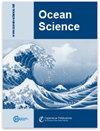纳入伴随海冰流变对估算北冰洋-海冰状态的影响
IF 3.3
3区 地球科学
Q2 METEOROLOGY & ATMOSPHERIC SCIENCES
引用次数: 0
摘要
摘要伴随同化方法已应用于耦合海洋和海冰模型的敏感性研究和北极状态估计。然而,伴随模式的精度由于对伴随模式的简化而降低,尤其是伴随海冰流变。作为海洋和海冰耦合估计系统持续发展的一部分,我们合并并近似粘塑性海冰动力学的伴随(伴随vp),并通过同化实验将其与自由漂移海冰动力学的伴随(伴随fd)进行比较。与伴随式fd相比,使用伴随式vp可进一步降低7.9%的成本,并显著改善了北冰洋开放水域和中间层的海洋温度。通过引入不同的海冰退缩过程,联合vp比联合fd更有效地调整模型输入。例如,从5月到6月,联合fd通过过度调节气温(bbb80°C)使边缘海域的海冰融化1.0米;伴随vp在其先前的不确定性范围内对大气状态进行较小的调整后再现了海冰退缩。伴随模式的这些发展为通过综合调整模式的初始条件、大气强迫和参数进一步改进北冰洋和海冰估算奠定了基础。本文章由计算机程序翻译,如有差异,请以英文原文为准。
Effects of including the adjoint sea ice rheology on estimating Arctic Ocean–sea ice state
Abstract. The adjoint assimilation method has been applied to coupled ocean and sea ice models for sensitivity studies and Arctic state estimations. However, the accuracy of the adjoint model is degraded by simplifications of the adjoint of the sea ice model, especially the adjoint sea ice rheologies. As part of ongoing developments in coupled ocean and sea ice estimation systems, we incorporate and approximate the adjoint of viscous-plastic sea ice dynamics (adjoint-VP) and compare it with the adjoint of free-drift sea ice dynamics (adjoint-FD) through assimilation experiments. Using the adjoint-VP results in a further cost reduction of 7.9 % in comparison to adjoint-FD, with noticeable improvements in the ocean temperature over the open water and the intermediate layers of the Arctic Ocean. Adjoint-VP adjusts the model input more efficiently than adjoint-FD does by involving different sea ice retreat processes. For instance, adjoint-FD melts the sea ice up to 1.0 m in the marginal seas from May to June by overadjusting air temperature (>8 ∘C); adjoint-VP reproduces the sea ice retreat with smaller adjustments to the atmospheric state within their prior uncertainty range. These developments of the adjoint model here lay the foundation for further improving Arctic Ocean and sea ice estimations by comprehensively adjusting the initial conditions, atmospheric forcings, and parameters of the model.
求助全文
通过发布文献求助,成功后即可免费获取论文全文。
去求助
来源期刊

Ocean Science
地学-海洋学
CiteScore
5.90
自引率
6.20%
发文量
78
审稿时长
6-12 weeks
期刊介绍:
Ocean Science (OS) is a not-for-profit international open-access scientific journal dedicated to the publication and discussion of research articles, short communications, and review papers on all aspects of ocean science: experimental, theoretical, and laboratory. The primary objective is to publish a very high-quality scientific journal with free Internet-based access for researchers and other interested people throughout the world.
Electronic submission of articles is used to keep publication costs to a minimum. The costs will be covered by a moderate per-page charge paid by the authors. The peer-review process also makes use of the Internet. It includes an 8-week online discussion period with the original submitted manuscript and all comments. If accepted, the final revised paper will be published online.
Ocean Science covers the following fields: ocean physics (i.e. ocean structure, circulation, tides, and internal waves); ocean chemistry; biological oceanography; air–sea interactions; ocean models – physical, chemical, biological, and biochemical; coastal and shelf edge processes; paleooceanography.
 求助内容:
求助内容: 应助结果提醒方式:
应助结果提醒方式:


